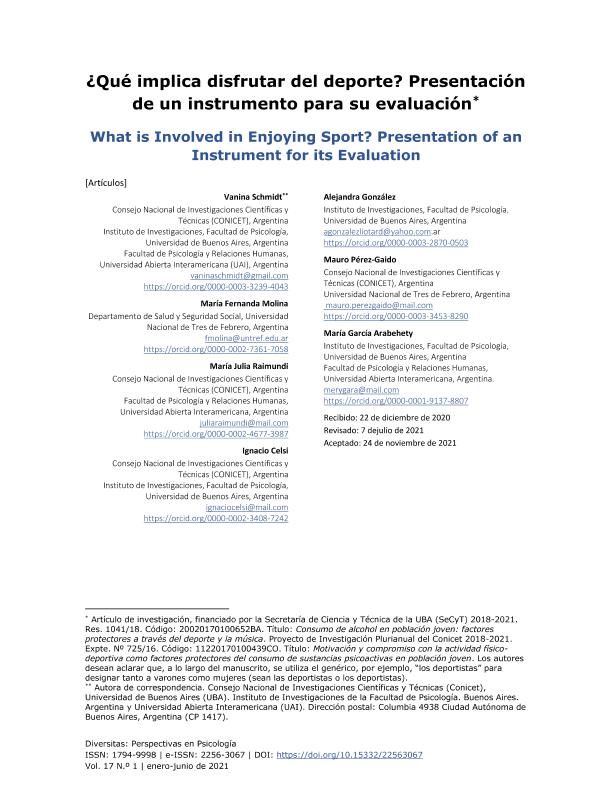Artículo
El disfrute es una de las razones más fuertes para involucrarse en una actividad deportiva. ¿Pero cómo se puede definir conceptual y operacionalmente este constructo? El objetivo del presente estudio fue indagar con enfoque mixto los componentes del disfrute en el deporte. En el primer estudio participaron deportistas federados del Área Metropolitana de Buenos Aires (AMBA, Argentina) (n = 9). Se utilizó una entrevista semi-estructurada y se identificaron las categorías que describen la experiencia de disfrute, tales como, afecto positivo, involucramiento y experiencia autotélica. Los participantes refirieron además sentirse realizados a nivel personal. Por otro lado, en el segundo estudio participaron 362 jóvenes (57.2 % hombres y 42.8 % mujeres) de 14 a 29 años de distintos clubes del AMBA. Para este estudio se operacionalizaron las categorías del primer estudio, a través de 29 ítems, con una escala Likert de cinco puntos de acuerdo. El análisis factorial exploratorio arrojó dos factores que explicaron el 58.8 % de la varianza a través de 17 ítems. La confiabilidad de cada subescala fue alta. El disfrute puede conocerse a través de dos subescalas: afecto positivo e involucramiento. Un factor adicional emergió de los análisis: el sentido de realización personal. Los factores del disfrute correlacionaron positivamente con este último, con el compromiso en el deporte y con el Flow total. Posteriores estudios permitirán conocer otros indicadores de validez de la escala y su uso en diversos contextos. Enjoyment is one of the strongest motives to engage in a sports activity, but how can this construct be conceptually and operationally defined? This study aimed to investigate, with a mixed approach, the components of enjoyment in sport. In the first study, federated athletes from the Metropolitan Area of Buenos Aires (MABA, Argentina) participated (n = 9). A semi-structured interview was conducted, and the categories that describe the enjoyment experience were identified, such as positive affect, involvement, and autotelic experience. Participants also reported feeling fulfilled on a personal level. On the other hand, the second study involved 362 young people (57.2% men and 42.8% women) aged 14 to 29 from different MABA clubs. For this study, the categories of the first study were operationalized through 29 items, with a Likert-type scale of five points of agreement. The exploratory factorial analysis yielded two factors that explained 58.8% of the variance through 17 items. The reliability of each subscale was high. Enjoyment can be assessed through two subscales: positive affect and involvement. An additional factor emerged from the analyses: the sense of personal fulfillment. The factors of enjoyment correlated positively with the latter, with the engagement in the sport and with the total flow. Subsequent studies will reveal other indicators of the validity of the scale and its use in various contexts.
¿Qué implica disfrutar del deporte?: Presentación de un instrumento para su evaluación
Título:
What is Involved in Enjoying Sport?: Presentation of an Instrument for its Evaluation
Schmidt, Vanina Ines ; Molina, María Fernanda
; Molina, María Fernanda ; Raimundi, María Julia
; Raimundi, María Julia ; Celsi, Ignacio Agustín
; Celsi, Ignacio Agustín ; González Liotard, Alejandra; Pérez Gaido, Mauro Gabriel
; González Liotard, Alejandra; Pérez Gaido, Mauro Gabriel ; García Arabehety, María
; García Arabehety, María
 ; Molina, María Fernanda
; Molina, María Fernanda ; Raimundi, María Julia
; Raimundi, María Julia ; Celsi, Ignacio Agustín
; Celsi, Ignacio Agustín ; González Liotard, Alejandra; Pérez Gaido, Mauro Gabriel
; González Liotard, Alejandra; Pérez Gaido, Mauro Gabriel ; García Arabehety, María
; García Arabehety, María
Fecha de publicación:
08/2022
Editorial:
Universidad Santo Tomás
Revista:
Diversitas
ISSN:
1794-9998
e-ISSN:
2256-3067
Idioma:
Español
Tipo de recurso:
Artículo publicado
Clasificación temática:
Resumen
Palabras clave:
DISFRUTE
,
DEPORTE
,
INVOLUCRAMIENTO
,
REALIZACIÓN PERSONAL
Archivos asociados
Licencia
Identificadores
Colecciones
Articulos(SEDE CENTRAL)
Articulos de SEDE CENTRAL
Articulos de SEDE CENTRAL
Citación
Schmidt, Vanina Ines; Molina, María Fernanda; Raimundi, María Julia; Celsi, Ignacio Agustín; González Liotard, Alejandra; et al.; ¿Qué implica disfrutar del deporte?: Presentación de un instrumento para su evaluación; Universidad Santo Tomás; Diversitas; 18; 1; 8-2022; 1-21
Compartir
Altmétricas



